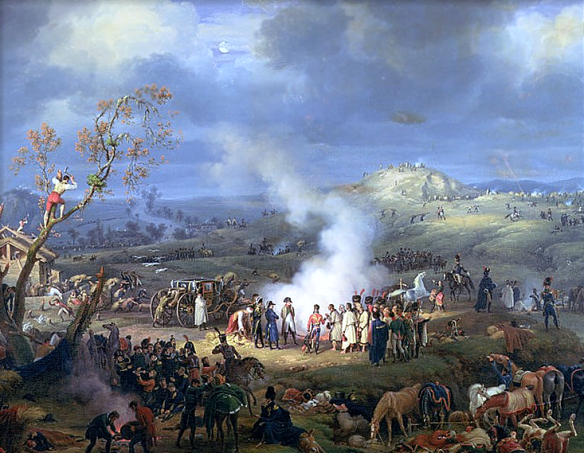The army that Napoleon inherited from Louis XVI of France and from the early Revolutionary councils was ready-made and had battle experience. What he did with that army was truly remarkable, even more so when it is acknowledged that Napoleon himself was no great innovator. He applied already-established concepts and, by the strength of his own personality, his brilliant leadership, and his understanding of the men he commanded, transformed the defeated army of the Seven Years’ War (1756-1763) into an almost invincible force.
Napoleon took command of the (French) Army of Italy on 27 March 1796. He had some 58,000 men who were short of food and clothing and strung out along the coast from Marseilles to near Genoa. His success in this campaign was due to the characteristics mentioned above and to his strategy of hitting at enemy weak points and attacking where he was sure of victory. By 25 April he had defeated Johann Peter Freiherr von Beaulieu’s right wing at Dego and Michael Freiherr von Colli’s at Mondovi. His campaign continued with the brilliant coup at the Lodi Bridge, showing how much he believed in a commander’s power to inspire men. His subsequent campaigns all demonstrated the validity of this concept.
One Napoleonic Order of the Day (bulletin to the troops) stated clearly how he thought the French soldier ought to respond to his particular call to arms; he posed it as an individual challenge to each of them: “All men who value life more than the glory of the nation and the esteem of their comrades should not be members of the French Army” (Chandler 1998, 149). His personal appearance at the crucial moment of a battle was profound: the famous British military historian and strategist General J. F. C. Fuller wrote that Napoleon said, “When in the fire of battle I rode down the ranks and shouted, `Unfurl the standards! The moment has at length come!’ it made the French soldier leap into action” (quoted in Fuller 1970, 194). The art of leadership has rarely had a more able exponent.
Officers and Headquarters
The Revolution brought with it almost universal liability to serve in the French Army, and the decree of the new military constitution of February 1790 declared that every citizen of the new French Republic was admissible to every rank and appointment. Many officers (some two-thirds of the original 10,000 of 1789) left to join the émigrés at Trier or Coblenz (Koblenz), unwilling to serve the new government and wary of their prospects in view of the antiaristocratic stance of the Revolutionaries. However, some officers stayed, loyal now to the new system, and they saw how an army could be increased by forced growth.
Perhaps the best example of the continuity of command was that of Louis-Alexandre Berthier, Napoleon’s chief of staff. In 1780 he was aide-de-camp to the comte de Rochambeau (who commanded the French army in North America during the American Revolutionary War), in 1789 he was a lieutenant colonel and chief of staff to the baron de Besenval (commander of the French army around Paris), and by the end of that year he was assistant quartermaster general on the staff of the new National Guard. He held a number of staff appointments thereafter, and was appointed chief of staff to Napoleon in 1796, a post he held until the end of the campaign of 1814.
Nor was Berthier the only professional in Napoleon’s officer corps. General Jean-Baptiste Jourdan was another whose staff work was exemplary. Jourdan was known for the efficient manner in which he drew up and issued orders for the following day in a timely manner, each division receiving information on its objectives and movements, yet with the divisional commander left to sort out the finer details of the task given him: A perfect example of Auftragstaktik (leaving execution of a task to the recipient of an order) long before the word was coined.
Napoleon’s headquarters were divided into the Maison and Army Headquarters. Within the Maison were his immediate court (some 800 during the Jena-Auerstädt campaign in 1806) and his personal military staff. The Emperor’s court also included the imperial cabinet, whose few members were of great importance in assisting Napoleon to formulate his plans. The cabinet included the chiefs of the Topographical Office and the Statistical Office, which supplied Napoleon with the analysis and maps of the ground over which he would operate and the details of the strengths of allies and enemies, respectively.
Army Headquarters, which was sited alongside the Maison, consisted of Berthier as chief of staff, his aides, and the General Staff of the Army. The General Staff was itself subdivided into the offices of the chief of the General Staff (who directed the work of the whole), the assistant chief (the quartermaster of the army, responsible for accommodation and marches), and the assistant chief (who had the Survey Department under him). The task of this last officer was to provide daily situation maps. Also included in the headquarters were the intendant general, the commander of artillery, the commander of engineers, and the colonels general of the Imperial Guard.
When Napoleon was at the planning stage of any operation he had behind him a professional staff able to move his army, concentrate it where needed, and also able to provide logistical support and operational engineering units to ensure that bridging and other transport matters were taken care of. Many countries and armies later adopted the structure of Napoleon’s headquarters, with varying degrees of success, and today, as then, the smooth operation of headquarters can determine the success or failure of a campaign or mission. Napoleon chose men who could make things happen for him, not men who were timeservers or egocentrics.
